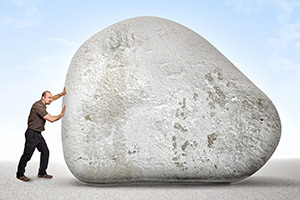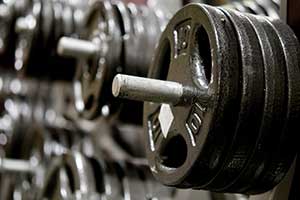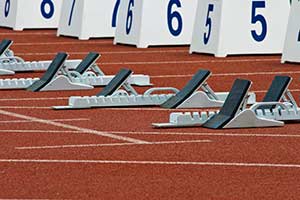
By Carl Valle
A lot of ideas and theories exist on the internet based on more coach’s lore than basic math and introductory sport science. With so many experts refuting each other, it’s a good idea to keep the suggestions simple and clear based on video evidence of the NFL combine and the times and other scores the elite football players are doing. While this is an article to help you run a faster 40 yard dash, it does provide some help in improving general acceleration in all sports that involve running. Now that the NFL is televising the testing and video is on YouTube and other channels, we can start disproving some rather outlandish ideas and some good advice that at first glance sounds reasonable. The truth is usually seeing something on video or testing theories through research studies with athletes, and we will explore the what works and what doesn’t’ with science, history, and a little logic.
Myth 1: Heavy object pushing is the key to acceleration because it works specific strength

A few variables are important to dissect when looking at any activity claimed to be the Holy Grail with improving athletes, specifically when looking at research with different levels of athletes. Early in training, such as beginners or youth athletes will respond to nearly anything as training age, experience with formal workouts that is, determines how and why athletes improve. Heavy sleds can improve an athlete, but pushing trucks and loading up a prowler is no automatic ticket to getting faster in the 40 yard dash. If it was, with every major college and facility would have had legions of athletes that are running faster than Chris Johnson or C.J. Spiller. We do know that general strength training does help athletes with inertia, or in simple terms overcoming gravity at rest, but the true question is how does heavy pushing prove to be more effective than conventional approaches in the weight room, normal sprinting programs, and classical loads on sled sprints? Many athletes who don’t lift or don’t have the skills in lifting weights can load up a sled without much learning and have great abilities to push an object, but compared to an advanced athlete not much evidence supports so. What is likely is that athletes need more overload specifically in acceleration and that can be done with lighter sleds without any evidence of impairing mechanics to the point it will lead to poor performances later by poor motor skills. Any approach that leads to consistent and significantly better times is the best method, provided it’s safe and repeatable. A good idea is to time the training sessions and compare all methods to see both the acute improvement over a short period and the long term development of a developing athlete. From practical experience, heavy sled sprinting, even at loads higher than the classic 10% rule, is far better use of limited time because it allows a total body sprinting motion with arms instead of a shopping cart position that most stay in when pushing objects.
Quick Tip – It’s better to be well rounded and have a great program with mastering the basics than to look to one option to solve everything. Sleds can be loaded with any load provided it doesn’t interfere with the development of speed. With short periods of time of preparation with athletes, a lower load near 10-20% of bodyweight is suggested to allow for both an overload and the exposure of sprinting. Auditing a program with both video and electronic timing is the most straight forward way to ensuring what is done is working.
Myth 2: Focus on Stride Length for faster times as stride frequency will slow you down

The artificial separation of a sprint stride into frequency and length is not a new discussion, and now many have focused on talking about applying forces horizontally (pushing back) and vertically (pushing down). The truth is that the resultant, or combination of all forces (sometimes lateral) is important in acceleration and top speed and a well-rounded program in both the weight room and on the track or football field will cover the bases to improvements in speed. Improvements in speed yield improvements in times one is getting in practice and in testing or competition. Unless an athlete is running with very strange technique, be it taking excessively long strides that are slow or cutting off their stride and no going anywhere, one should focus on approaches that pass the eye test (aided by video when possible) and pass the time test (electronic timing). Counting steps may be useful for those that are rushing the start, being lured into the feeling of moving the limbs fast to feel fast, but the displacement of their center of mass or body is not working according to the watch. Keep in mind though an athlete may make great improvements in speed and have the same step count in the first 10 yards because they are stronger and are able to depart lower, so it’s imperative that one be again audited by the obvious benchmark of speed or time on the clock. Lower acceleration, or leaning more aggressively will reduce the first steps in length, but the added speed more than negates that disadvantage. Athletes will perceive what fast feels like differently and sometimes not accurately, so calibrating what the athletes feel to the actual times and sometimes video is especially helpful.
Quick Tip – The best combination of evaluating a performance is both time and video. Good times are a result of mechanics and power from training, and looking for full ranges of motion with the athlete trying to strike rapidly with fast arm actions. Full range movement on video prevents quick action of the limbs but slow times on the watch, and the coach and athlete are responsible for finding the best combination that works for them.
Myth 3: Max speed mechanics are not important in short sprints

The most visible difference between acceleration and top velocity besides the obvious speed being higher in the latter, is the body angle being leaning deep in early acceleration and upright at top speed. In the 40 yard dash we tend to see most, if not nearly all the distance being acceleration with only the last part having upright running. So, this begs the question: does one put any effort into the small but noticeable part of the test. With every hundredth mattering for evaluation, be it valid or not, one should devote some effort in addressing the end because of two important considerations. One, the idea of going to any test without experiencing some semblance of running fast at the end of the 40 yard dash doesn’t prepare for having an ultimate performance when everyone now is rehearsing good starting technique. Years ago investing money into preparing the combine was unheard of and those that prepared were artificially appearing superior as they were practicing the test and the other invitees were simply unprepared. Later every top draft pick had combine preparation, especially learning how to start faster and more consistent. Now, having a good start is just the start, and improvements still can come from finishing strong. Second is the risk to pulling hamstrings, something that can be reduced if one “tastes” top speed with a few runs so the strain of running fast and mechanically upright is imprinted to the athlete so it’s not exposing an athlete to being in an activity they are not experienced in at maximal effort. Remember that many skill positions and team sports may have a focus on acceleration, but most teams are standing nearly upright during the game and lean forward a little rather than starting in three point stances. Of course risk must be mitigated by managing how fast and how much one is doing in practice to eliminate fatigue and overexposure to hamstring stress. Some coaches have elected to entirely remove longer running as a conservative approach and succeed, but it’s good to see how the end times are finishing compared to the first 20 yards to see if the athlete is at par with his or her counterparts.
Quick Tip – A taste of top speed can be a help if done right, but it’s better to be conservative and show up to the combine than be too focused on top speed and risk injury. The best mediation in deciding what is best for you or your program is do some sub maximal form running in the warm-up so one has done something to address the need for both performance and injury reduction instead of settling for nothing. One’s risk tolerance will determine what is worth doing and that decision is very individual.
Myth 4: A short arm swing at the start creates a faster performance
In a three point stance, the athlete has two feet staggered and one hand near the line, thus the name three point start coined for three contacts to the ground. The free arm is usually near the the hip or some have it straighter and further back while some elect to keep the non-contact arm closer to the other arm. Since running, including the start, involves alternating right and left arms and legs in an opposing fashion, the question would be can a quick arm action with less range of motion increase speed? With less distance to cover, it appears at first glance that a short arm swing up near the head is going to be faster, but the arm is swing without resistance and the leg on the same side of the body needs to be able to finish pushing the weight of the body before one can start running. It’s not how fast the arm is that determines a great start, but how explosive and efficient the legs and torso at applying pressure behind the athlete. Arm action should be in harmony of the rest of the body and the arm swing is only as long time wise as the front leg needs to push back.
Quick Tip – The side arm that is not contacting the ground should be fast and full, meaning one should swing the arm as fast as necessary and a range of motion that is long as the athlete needs to be in synchronous harmony with the leg push. One may reduce the arm swing distance or mechanics if the athlete is pushing out faster, but experienced athletes will tend to improve by better timing of the body performing rather than the changes in power over weeks.
Myth 5: Focus on Olympic Lifts as they will get you a fast first 20 yards

For years the lore of infamous “1964 Olympic study”, one that never happened and one that was laced with inaccuracies and misinformation. First, the 1964 Olympics were not in Mexico City they were in Tokyo Japan. Second, 25 yard dash times are a little suspect when they convert to 22.8 meters, something that doesn’t sound like a true international test since most of the world is using the metric system and the distance is a little odd. I have seen no published studies that have been released, and doing homework, athletes from all the sprint and weightlifting events have never ever shared that they participated in such testing. Since the combination of Olympic lifting and sprinting is freely available, we would have seen freakish times in the NFL combine already. My experience with national level Olympic lifters that have sprinted for other sports such as bobsleigh and track and field, find the conversion to track not as easy as one would think. The first explosion is just as much horizontal as it is vertical, something some weightlifters find foreign and with acceleration being on the forefoot, rear pressured leg drive is a complete opposite demand. I have no doubt that Olympic lifting is beneficial to athletes, but the specificity of running does have limits to the transfer of outside actions like weight training, something that will be shared in more detail in the next article. A balanced approach of actual sprinting and lifting will likely yield the best results, so putting all your eggs in one basket is not a wise decision.
Quick Tip – If you are experienced and proficient in Olympic lifts don’t toss them away, but if you are not technically skilled and new, the addition of the exercises are too late in the game when just practicing starts is likely to do more than a quick fix in the weight room. Experimenting and good record keeping with both training programs and timing is a good way to see how the lift may be influencing the results of the sprinting.
Myth 6: Coaches should use External Cue words more than Internal Cues

One of the most popular trends in coaching now is motor learning and cuing, or the ability to teach athletes using special words to instruct the mechanics or technique of sport skills. It seems that everyone now is looking for the best words to tell athletes in order to have then acquire better technique in strength training and movements on the field. The truth of the matter is any cueing should be to a minimum, and the absence of cues is arguably better than talking. Athletes need to be shown what to do correctly and be given good tasks to skip the unnecessary processing of commands from people when they should be focusing on what they need to do without thinking. The classic paralysis by analysis, regardless if the words are poetic or pathetic, will slow down the speed of actions when the athlete is thinking. Cueing is sometimes valuable and an option, but some fantastic coaches have praised the saying “speech is silver but silence is golden” is especially true when gold medals have been won by athletes with coaches that adopted that mantra. A simple and effective task with no verbal barrier between the athlete and their own brain is sometimes the best process when they are learning, and this process is often called self-organization. Minimal cueing is the best approach as most coaches and athletes have very little time to prepare for combine testing during the year.
Quick Tip – Coaches and athletes need to be careful of expectations of words being the savior of technique during practice. On the other hand, discussions during video sessions are perhaps the best times to talk about technique and errors because an athlete can see for themselves what is going on. Whatever the approach is make sure one films and is timing to ensure what feels good is actually fast or evident in video.
Myth 7: Track Coaches are Poor Choices for Starting Technique

The common belief of many performance coaches is that Track coaches are not familiar with running out of a three point start when running coaches were the first to invent all of the starting positions in speed tests. The simple conclusion is that since track, specifically sprint coaches, are having athletes use blocks in races that they don’t know how to run fast without them is a sound idea but with deeper investigation it’s more protectionism than truth. The reality is Track or athletics when referred to internationally should be followed by Field. Track and Field have events such as jumping and throwing, and many of the events are examples of acceleration being important, all without blocks. Field events such as the horizontal and vertical jumps rely on effective acceleration in order to achieve speed to create potential vertical or horizontal distance. Many athletes in sprints don’t use blocks in training and have used different starting techniques to get workouts done, so track and field coaches could be the best resources for teaching effective starts. Another point is that blocks have excellent research of how they contribute to acceleration, and those studies serve as great direction to ideal models. After the optimum models are created, coaches have the ability to adjust less than ideal circumstances, such as the simple absence of blocks, to manipulate the body into positions that will enable for fast times.
Quick Tip – Use coaches with a history of getting athletes faster, regardless of their title and visit them in action to see yourself. Sometimes a local coach is a great resource but big names are popular from results as well, so shop wisely. The set-up position of the combine requires mainly focus and getting into the right stationary position, something all athletes can do, regardless of talent and ability.
Summary
In closing, a lot of information is available on combine preparation and speed training, and the best answer is to keep the training straight forward and very vanilla, meaning don’t get fancy or extreme in training. The use of smartphones or high end cameras help explain why some runs may be executed better than others, but timing helps cut to the chase and see if the athlete is intact improving or expressing speed in practice. Over weeks one should see both an improvement in consistency (range of times) and improvement in performance (average and top splits). A little experimentation and talking to coaches and athletes who are experienced in sprinting, both on the track and on the field should help find what works best for you.
Please share this article so others may benefit.
[mashshare]


Well done… My only argument/complaint is that you left out overspeed treadmills.
I like Olympic lifts, but like all lifting its to two dimensional, speed/acceleration/balance is three dimensional.
So please explain how joe defranco has been implementing and using heavy sled pushes and sprints for years now, and creates some of the fastest athletes? Also after puberty it is nearly impossible to increase stride frequency and according to research and testing, who ever runs the race in the fewest steps wins. Perfect example is usain bolt
The article says that heavy sled pushes AND speed work together can be successful, but that the conventional ‘no more than 10% loading rule’, when combined with the use of total body sprint mechanics, is better if pressed for time. Also, Usain Bolt certainly has higher stride length, but also more than adequate stride frequency. In the past, shorter sprinters had much higher stride frequency than taller sprinters, which more than made up for the difference in stride length.
This is fuckin stupid I push sleds and lift heavy Olympic lifts everyday, I also run track and guess what I ran an official time of 4-3. This page Doesn’t make sense everyone is different so u do what works best for u also building bigger and stronger legs also helps u run faster so don’t listen to this page some of the things are true but it also has to work for u